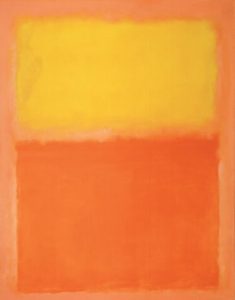Color field painting – Mark Rothko
A second variety of Abstract Expressionism offered viewers a more meditative and quiet painting based on large expanses of relatively undifferentiated color. Mark Rothko (1903-1970) began painting in the early 1940s by placing archetypal figures in front of large monochromatic bands of hazy, semitransparent color. By the early 1950s, he had eliminated the figures, leaving only the background color field. The scale of these paintings is intentionally large. Green and Blue, for instance, is over 7 feet tall.

Viewers find themselves enveloped in Rothko’s sometimes extremely somber color fields. These expanses of color become, in this sense, stage sets for the human drama that transpires before them. As Rothko explains,

Rothko was also fixated with the literary work of Friedrich Nietzsche, above all the German philosopher’s seminal opus The Birth of Tragedy from the Spirit of Music written in 1872, which impacted Rothko’s colour field iconography. This major treatise intently examines the nature of culture from the perspective of Greek mythology. Nietzsche dissects cultural difference according to the schism between Apollo, god of the sun and lightness, and Dionysus, god of wine and ecstasy. These two divergent sons of Zeus represent a metaphysical dichotomy in value systems. Apollonian characteristics include clarity, critical reason, self-control, perfection, and individuality; [evident in the ordered shapes and lines that define color] whereas Dionysian traits comprise intoxication, passion, dissolution of boundaries, and wholeness [evident in the bold colors]. Although the ancient Greeks did not consider the two gods as opposites, Nietzsche saw the interplay between the Apollonian and the Dionysian as the kernel prerequisite for the creation of tragedy in art. [2]

